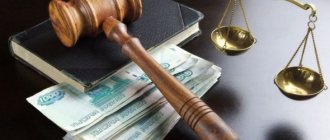By purchasing a car, the owner assumes additional responsibility and risks associated with possible illegal actions in relation to the property. This also applies to damage to a vehicle, which can be caused equally either intentionally or accidentally.
Often, having damaged someone else's car, the culprit prefers to silently hide, leaving the owner of the car to repair the damage on his own. In our article we will look at what liability is provided for damage to someone else’s property, in particular, everything related to a car.
Important! If you are dealing with your own case related to car damage, then you should remember that:
|
Damage to property due to negligence - Article 168 of the Criminal Code of the Russian Federation
Life is complex and unpredictable: often a person becomes a source of other people's problems, without wanting it.
The developers of criminal regulations tried to provide for this by establishing the following types of liability for an accidental culprit :
- monetary punishment up to 120 thousand rubles;
- payment towards the affected annual income;
- work: compulsory, corrective and forced (for a period of up to 480 hours, up to two years and a year, respectively);
- prison (the term here depends on the degree of unseemly behavior - maximum 12 months).
It is worth noting: the main semantic points of this legal text: the large size of the damaged/destroyed objects and the unintentional actions of the criminal (frivolity/negligence). And “large” in criminal law is calculated from the amount of a quarter of a million rubles.
The comments to the text say that the action applies to people over 16 years of age. So some “children under 18” are mistaken, hoping that they will not face serious punishment for a bad act.
Damage to a vehicle outside of an accident
Damage to a car outside of a traffic accident refers to situations where damage to a car occurs in the courtyard of a house, in a parking lot, in service centers, etc. The difference between such cases is, as a rule, the complete absence of fault of the owner whose car was damaged, and the vehicle during commission of illegal actions was in a static state (without movement).
Liability for damage caused is provided for both by the Code of Administrative Offenses of the Russian Federation (CAO RF) and the Criminal Code of the Russian Federation (CC RF). The question of what type of liability is provided in a particular case is resolved by assessing the damage caused to the vehicle. The fundamental assessment criterion is the amount of damage - criminal liability is provided only in case of significant damage. How significant the damage is is determined in each case individually, taking into account the property status of the injured person.
Administrative liability involves the imposition of a minor fine on the guilty person, while criminal liability involves a significantly larger fine, mandatory, corrective, forced labor, and even imprisonment. The assignment of punishment will depend on a number of criteria, including mitigating and aggravating circumstances, and the form of guilt - intent (in accordance with Article 167 of the Criminal Code of the Russian Federation) and negligence (Article 168 of the Criminal Code of the Russian Federation).
Intentional damage to someone else's property - Article 167 of the Criminal Code of the Russian Federation
Part 1 reproduces two circumstances: malicious intent of actions against possession and serious damage caused by them.
Once convinced of their coincidence, the judge appoints:
- a fine in the amount of up to 40 thousand;
- payment by the culprit of annual earnings;
- work: compulsory, corrective and forced (up to 360 hours, up to a year or two years, respectively);
- detention (up to three months);
- prison (maximum – up to two years).
In Part 2, intentional damage to property for hooligan motives makes it possible for even a 14-year-old to get five years of forced labor or prison.
The text reproduces the following composition of the incident:
- seriously damaged material assets;
- organized arson or explosion that could harm third parties;
- the actions of the criminal unexpectedly caused death/other serious consequences.
It should be taken into account: if the person who committed the evil deed tried to destroy the evidence, his guilt is seriously aggravated: this is already an attempt to evade justice. The case is being considered under another article of the Criminal Code.
How to recover damages
The first step of the victim is to write a statement to the police about the loss or damage of things. The application states to whom and from whom it is being sent: the name of the unit, the victim’s details, address and telephone number.
Then you should describe under what circumstances the offense was committed, when and who discovered it, and indicate the approximate cost of the damage.
If there is any idea who did this, then this should also be noted in the statement. Then the victim must write what she demands: criminal or administrative punishment.
The investigator examines all submitted documents, interviews the victim, witnesses and the offender, or takes action to capture him. Then makes a decision to initiate a case.
The offender can avoid criminal punishment if he voluntarily agrees to make all payments to the victim.
If this does not happen, the investigator issues a decision to initiate criminal proceedings and orders an examination.
After the examination, the victim must file a claim to recover the cost of the items and moral damages.
This can be done regardless of whether criminal or administrative punishment is imposed on the offender.
The claim is filed either with a magistrate (if the price does not exceed 50,000 rubles) or with a civil court at the place of registration. The claim describes the circumstances of the incident, the demands of the victim, and attaches all documentary evidence.
It is advisable that upon the initial discovery of a crime, a property damage report should be drawn up. It can be drawn up by property owners with the participation of representatives of housing and communal services, police officers, firefighters, and medical workers (if damage to health is caused).
The act must include the date, time, place of the offense, a list of damages, the alleged offender, members of the commission, and conclusions drawn based on the examination.
Three copies of the document are required, one of which is handed over to the police and will serve as evidence in court.
A person’s actions that lead to the loss or damage of someone’s property are punishable under an administrative or criminal statute.
It depends on the size of material losses and the severity of the consequences
In this case, it does not matter what was the motive for the crime, it will still not be recognized as a mitigating circumstance.
An example of a property damage report.
You can learn about liability for damage to someone else's property from the video:
https://youtube.com/watch?v=v780_foScb0%3Fecver%3D1
Didn't find the answer to your question? Find out how to solve exactly your problem - call right now:
| Share with friends: |
Did you like the article? Follow site updates or.
Comments:
Liability for damage to someone else's property
Its type and degree are determined by the following things:
- motives (unkind arbitrariness or carelessness) of the perpetrator;
- depending on the owner of the damaged property: a private individual seeks punishment under articles 167 and 168, and the state – under articles on vandalism;
- consequences for public order and the lives of others.
In such cases, there is a lot of controversy around the concept of “material value”. If a house burns down or expensive equipment breaks down, the crime is obvious.
What if digital media containing valuable business information is damaged? Here everything is no longer so clear and it is more difficult to hold the perpetrator accountable to the fullest extent of the law.
Good to know: mistreatment of rental property can also lead to criminal charges.
Administrative responsibility
Article 7.17 of the Code of Administrative Offenses specifies a violation in the form of deliberate destruction or partial damage to material assets. The fact of liability is not affected by the type of property in relation to which illegal actions were committed. The main thing is confirmation of the amount of damage caused. A citizen will be held accountable only when the assessment of damage does not exceed insignificant amounts, namely 5,000 rubles .
The only type of penalty applied to violators in this case is a fine. Its size varies between 300-500 rubles.
The punishment is assigned by the judge considering the material. A protocol on violation is drawn up by the police and submitted to the magistrate’s court of the locality.
Attention! For causing damage to property, according to the Code of Administrative Offenses of the Russian Federation, citizens who have reached the age of 16 can be held accountable.
Punishment for damaging a car
It is determined from the nature of the damage and the circumstances of its infliction - and the spread here is very large.
Anyone who breaks a tire (even with bad intentions, say, out of revenge) faces a maximum fine of up to 500 rubles. Because the repair will cost the owner less than 2.5 thousand rubles - the case will fall under the code of administrative violations.
But if restoring the car requires more than a quarter of a million, or the car is completely destroyed, or an attacker set fire to or blew up the vehicle, this is already a criminal case under the articles discussed above. After all, in addition to the two sides, there is a threat to outsiders.
Arbitrage practice
Many cases of property damage are intentionally related to conflict situations that arise between people. This is especially common among road users.
One of the high-profile criminal cases is a traffic conflict between two well-known individuals: deputy Igor Amural and former law enforcement officer Sergei Kovalenko.
In connection with the conflict between citizens due to an accident, one of them intentionally caused damage to the property of the second defendant (second part of Article 167 of the Code), in response to which the second participant in the proceedings caused the following types of harm to his opponent:
- Mild harm to health.
- Causing retaliatory damage to a car (the first part of the article under consideration).
Information about which crimes specifically were charged with which of the participants was not disclosed to the public.
The materials of the case under consideration were transferred to the court, but the judicial authority returned them for further investigation due to insufficient evidence.
Compensation for damage to property
Causing property damage can be punished only by providing the culprit and evidence.
When a neighbor from above flooded the residents on the floor below, forgetting to turn off the water - everything is clear here.
And if, upon leaving the house in the morning, a person finds punctured tires on his car, one can only hope that there will be witnesses or cameras that recorded the moment the crime was committed. If hopes are not justified, then it is unlikely that contacting the police will somehow help the victim.
To be called to account, you need to officially record the fact of what happened - depending on the situation, through the management company, a police representative or the traffic police. Based on this document, an examination and report on the damage caused is made. With this, you can already contact the culprit.
You can peacefully agree with an adequate person on voluntary compensation for damage by drawing up an agreement or taking a receipt. Otherwise, or if the agreement is not fulfilled, you can go to court.
How to determine the extent of damage
To assign punishment and compensation for damage to the victim, the cost of the damage must be correctly assessed.
For this purpose, the investigator orders an examination.
It is carried out by an organization that has the appropriate license.
The expert takes into account such points as:
- how much the item costs on the market at the moment;
- what is the percentage of depreciation of the property;
- Is it possible to restore or will I have to purchase a new item?
Most often, as part of a criminal case, an examination of the following property is carried out:
- Cars. If the damage is minor, then it is easy to assess the damage. Problems arise when the car is completely destroyed after a fire. Then the year of manufacture of the car, mileage, time spent in ownership, information about the accident in which the car was involved, and the cost of a car with similar characteristics must be taken into account.
- Household appliances, musical equipment, phones, tablets.
It is advisable that the victim keep the receipt for the purchase. Then the examination will take into account the year of production and the real price of the item. If there is no receipt, then the average price in stores at the time of purchase is taken as the basis. - House, building, store and other real estate. If the property is completely lost, then the price according to the cadastre on the day the offense was committed is taken. When a part of the house is damaged (windows, doors, roof, internal contents), then the prices for finishing materials in stores, the price for repair services, and the likelihood of restoration to its original condition are studied.
Luxury items: jewelry, furs, leather, paintings, etc.
Usually a person keeps receipts for these goods, so the expert is guided by the amount for which they were purchased.
Sample statement to the police about property damage.








